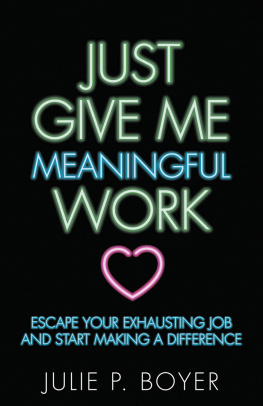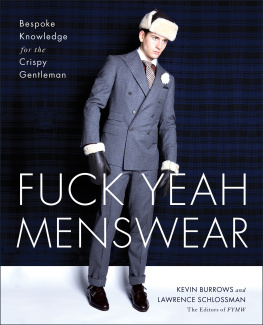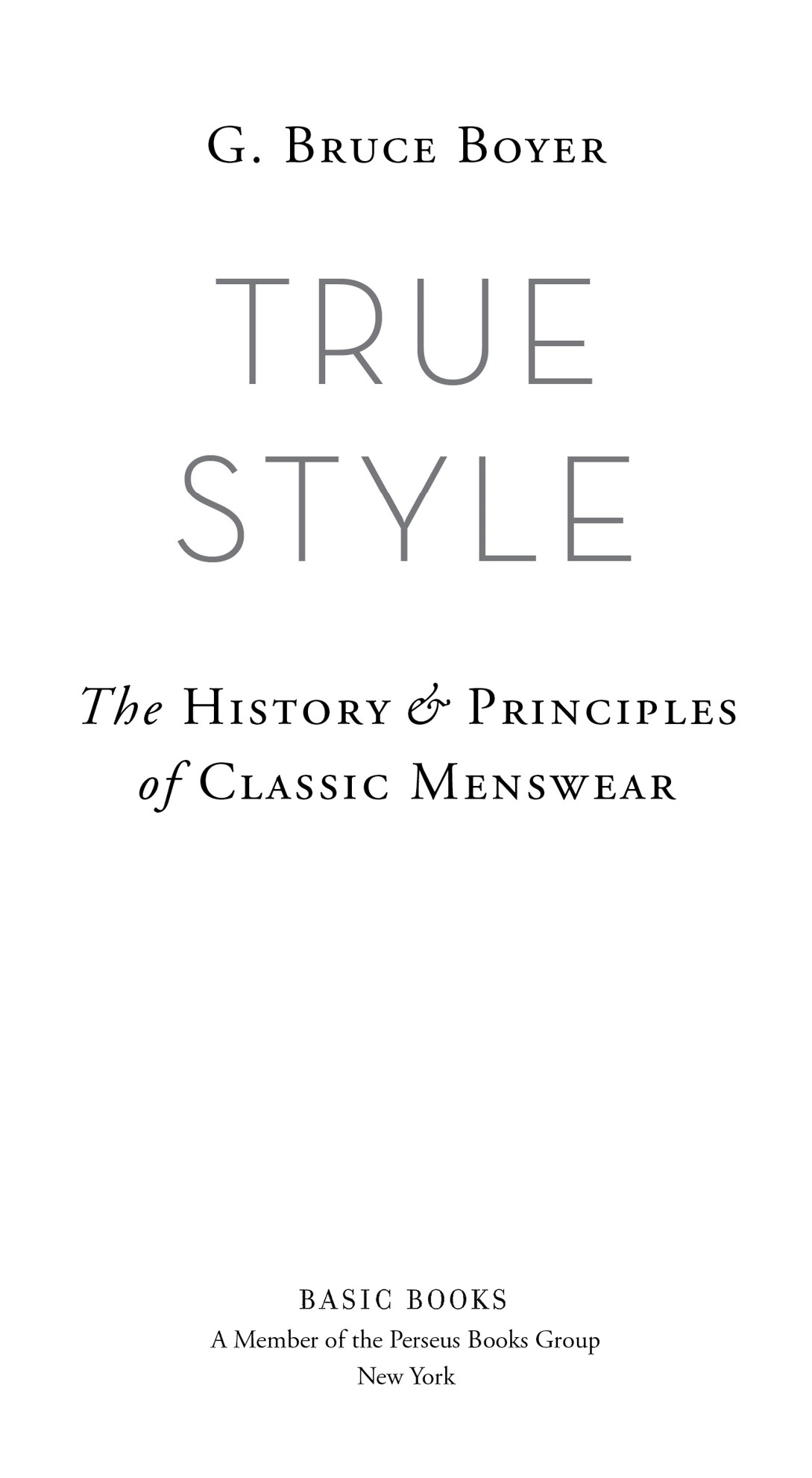More Advance Praise for True Style
The Ivy Style exhibition at The Museum of the Fashion Institute of Technology in New York City, for which Mr. G. Bruce Boyer was a consulting curator, is still being talked about among fashion leaders in Japan. We respect Mr. Boyer, whose appraisal of Ivy Style always influences new fashion trends worldwide.
Minoru Onozato, editor-in-chief, Free & Easy magazine
True Style combines historical insight, an elegant turn of phrase and sartorial authority, all enhanced with timeless illustrations. It is the perfect complement to the connoisseurs wardrobe and bookshelf.
Christopher Breward, University of Edinburgh
True Style is magic. G. Bruce Boyers delightful writing gives us a chance to contemplate the beauty and function of mens wardrobe essentials, transporting us to a world where old-world glamour and modern elegance rule. With rich erudition, Boyer brings together dress history, fashion pedagogy, smart anecdotes, and examples of timeless style icons to show how the art and pleasure of male dressing can be mastered.
Masafumi Monden, author of Japanese Fashion Cultures: Dress and Gender in Contemporary Japan
True Style
Copyright 2015 by G. Bruce Boyer
Published by Basic Books, A Member of the Perseus Books Group
Jane Kenyon, The Shirt from Collected Poems . Copyright 2005 by the Estate of Jane Kenyon. Reprinted with the permission of The Permissions Company, Inc. on behalf of Graywolf Press, www.graywolfpress.org
Illustrations by Spiros Halaris/Illustration Division All rights reserved. Printed in the United States of America. No part of this book may be reproduced in any manner whatsoever without written permission except in the case of brief quotations embodied in critical articles and reviews. For information, address Basic Books, 250 West 57th Street, New York, NY 10107.
Books published by Basic Books are available at special discounts for bulk purchases in the United States by corporations, institutions, and other organizations. For more information, please contact the Special Markets Department at the Perseus Books Group, 2300 Chestnut Street, Suite 200, Philadelphia, PA 19103, or call (800) 810-4145, ext. 5000, or e-mail .
Designed by Cynthia Young
Library of Congress Cataloging-in-Publication Data
Boyer, G. Bruce.
True style : the history and principles of classic menswear / G. Bruce Boyer.
pages cm
Includes bibliographical references and index.
ISBN 978-0-465-06159-4 (e-book)
1. Mens clothing. 2. Grooming for men. I. Title.
TT618.B69 2015
646.402dc23
2015019125
10 9 8 7 6 5 4 3 2 1
For Pam
Contents
You appear to read a good deal upon her which was quite invisible to me, I remarked.
Not invisible, but unnoticed, Watson. You did not know where to look, and so you missed all that was important. I can never bring you to realize the importance of sleeves, the suggestiveness of thumb-nails, or the great issues that may hang from a boot-lace.
SIR ARTHUR CONAN DOYLE, A CASE OF IDENTITY
Exactlythe great issues that may hang from a boot lace! How many times have our parents and teachers said much the same thing, admonishing us that prospective employers surreptitiously note the condition of our nails and shoes, and can read therein our whole character? Human resources directors, weve been led to imagine, must be trained by the FBI.
But of course its not just potential employers who notice such things. Parents and teachers obviously do. So too do actual employers and colleagues; lovers, friends, and acquaintances; andperhaps most importantly prospective lovers, friends, and acquaintances. Who among us has not scoffed at the ill-fitting suit of a stranger or stolen a disdainful glance at their coworkers frayed slacks? Who has not judged a date by the clothes he or she was wearing? Do we assume others dont do the same?
Conan Doyle knew what he was talking about: its the little things, the subtleties and miniscule details in the clothes you wear, that say the most. Is your hosiery over your calves, for instance, or do your socks sag down around your ankles, making your shins look like plucked chickens necks? Is your tie discreet or garish? And what about the pocket handkerchiefthe one for show, not for blow? Does it accentuate or clash with your shirt and tie? Is it even there at all?
Lets, for the moment, forgo the moral question about whether these matters of dress and grooming, of posture and manner should matter, because the reality is that they do. We must leave it to others to determine whether Oscar Wilde was right or wrong when he suggested that its only shallow people who dont judge by appearances. Suffice to say that comportment and appearance are noticedand that they speak volumes about us.
As Sherlock Holmes noted, the accessories that support the tailored wardrobe are of particular importance as personal and social indicators precisely because they tend to have no other real function, no utilitarian purpose, and are otherwise completely unnecessary except as symbols of status and clues to aspirations. Historically, jewelry is an obvious indicator of status for both men and women, but for the modern manat least, the modern man with a sense of taste and decorumthere are more subtle signs than large chunks of gold around the wrist or dangling from the sternum.
I never tire of sayingreaders might, but I dontthat clothes speak. In fact they never shut up. And the great danger is that if you dont hear them, youre not listening closely enough and will have to pay whatever penalty accrues from such inattention. As the English statesman Lord Chesterfield pointed out, dress is a foolish thing, and yet its a more foolish thing not to pay attention to it.
Not only do clothes speak, but they also lie less than words do. We know that most communication is nonverbal, and much of that is based solely on visual clues we gather from each other.
In todays world, when our quick meetings, fast meals, and ubiquitous technology have wedged a larger and larger space between us, we are forced to make decisions in nano-seconds and get our evidence wherever we can. Much of our evidence comes from our visual perceptions, from what we see. And what both individuals and society as a whole see is fashion. And because clothes speak, it follows that they constitute a sort of grammara set of rules that channel the vast possibilities of the language into meaningful, intelligible messages. Yet somehow, despite the obviousness of clothing as a tool of communication, we tend to take its grammar for grantedor even to deny its very existence.
I know most people dont read trade fashion magazines or blogs. I dont read them much myself with the zealousness I should. I suppose Im afraid theyll do something terrible to my brain pan. But I did pick up a magazine the other day, on the assumption that Id learn a bit from the lead article, entitled New World Order. I stopped reading after the first sentence: The new rule of dressing for the workplace is that there are no rules. It brought tears to my eyes. Of laughter.
Of rules there are no end, for fashion or anything else. Its simply that they change from time to time, sometimes slowly, sometimes with a quickness and ferocity unimaginable: whole empires gone in the blink of an eye. You may have noticed that, one recent summer, every man in the world seemed to be paring a navy blazer with white jeans. Very natty of course, but en masse you felt like the streets were populated by the chorus from Gilbert and Sullivans H.M.S. Pinafore. I mean, fair enough, its a chic look, but after youve seen thirty or forty men on the street wearing the Look, it gets a bit, well, boring. Its not that theres anything intrinsically wrong with a uniform; its just that it can become such a clich, revealing little more than that the man wearing it is achingly up to date and running hard with the pack.












